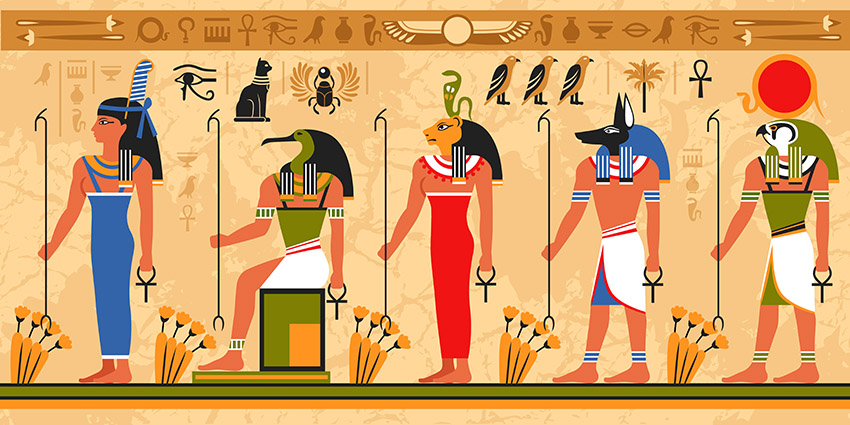The Origin of the Festival
Sham El Nessim actually dates way back to the ancient times in Egypt. It was a spring festival that the Egyptians have been celebrating since 2,700 BC. The festival is related to the agricultural background of ancient Egyptians.
Back in the ancient times, Egyptian used to determine the date of the festival based on the direction of the sunlight at sunrise over the pyramids. Later on, with the arrival of Christianity, the celebration used to follow the Christian Easter celebrations calendar. However, when Egypt turned into an Arab country, the date of Easter’s Day was scheduled to be on the 20th of April every year while the Coptic Easter, celebrated by Christians only, is celebrated on April 19th.
Activities of the Day
This festival is usually celebrated by heading out to places that are entitled for families’ gathering, including parks, gardens, and zoos. Among the traditions of this festival is enjoying specific meals that always include fish, onion and eggs.
Egyptian Easter Foods
One popular food that people binge on on Sham El Nessim is fish. It’s eaten in a fermented, salted, and dried gray mullet that is rather known as Fesikh. Although this food is annually warned of its dangers and possibility of leading to poisoning, Egyptians still adore and eat it. Other than fish, eggs and onions are also symbols of this celebration. Have you ever wondered why these three foods exactly?
Well, they had a symbolic significance to the Ancient Egyptians. Fish, for example, was a staple food in ancient Egypt due to its abundance in the Nile River. It was regarded as a gift from Isis, the mother Goddess. It also synmbolizes joyfulness, good luck, and wealth.
Moreover, eggs are a staple food associated with Easter celebrations around the world. However, onions were a worshipping object in the world of Ancient Egyptians. They believe that onions were symbols of eternity, which is why many Pharaohs were buried with onions.
أصـــــل العيـــــــــد
يعود الاحتفال بيوم شم النسيم إلى العصر المصري القديم. فهو عيد الربيع الذي اعتاد المصريون على الاحتفال به منذ ألفين وسبعمائة عام قبل الميلاد. ويرتبط هذا العيد بالحياة الزراعية للقدماء المصريين.
حيث اعتاد المصري القديم تحديد يوم العيد وفقًا لاتجاه أشعة الشمس وقت الشروق فوق الأهرامات. ومع ظهور الدين المسيحي بدأ الاحتفال وفقًا للتقويم المسيحي ولكن عندما صارت مصر دولة عربية صار الاحتفال بيوم شم النسيم في العشرين من شهر إبريل من كل عام بينما يحتفل الأقباط به يوم التاسع عشر من الشهر ذاته.
أنشطة العيد
اعتاد الناس على قضاء اليوم في تجمعات عائلية بهيجة في الحدائق العامة وحدائق الحيوان. ومن تقاليد الاحتفال الاستمتاع بوجبات معينة في هذا اليوم ولا سيما الأسماك والبصل والبيض.
وجبات شم النسيم في مصر
يعد السمك من أكثر الوجبات شهرة يوم شم النسيم حيث يتم تناول الفسيخ إلى جانب الأنواع الأخرى المملحة والمجففة. على الرغم من التحذيرات السنوية من خطورة تناول سمك الفسيخ الذي قد يتسبب في الإصابة بالتسمم فإن المصريين يعشقون تناوله. لكن بخلاف السمك يرتبط شم النسيم بتناول البيض والبصل. فها تعرف لماذا هذه الأكلات تحديدًا؟
تحتل هذه الأكلات أهمية رمزية عند قدماء المصريين. فالسمك مثلا طعام أساسي في مصر القديمة بسبب وفرته في نهر النيل. فضلا عن كونه هدية من الإلهة إزيس، إلى جانب أن الأسماك ترمز إلى السعادة والحظ السعيد والثروة.
البيض فهو طعام أساسي مرتبط باحتفالات شم النسيم في مناطق مختلفة حول العالم. أما البصل فله رمزية دينية عند المصري القديم لأنه يعبر عن الأبدية والخلود، ولهذا السبب نجد أن كثير من الفراعنة قد وضعوا البصل في مقابرهم.

